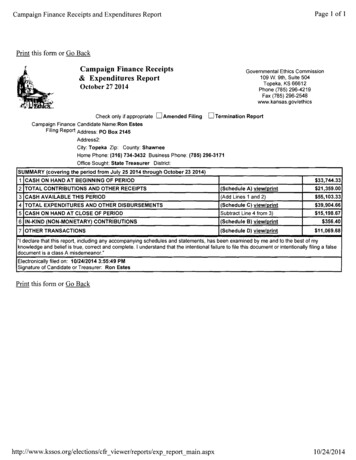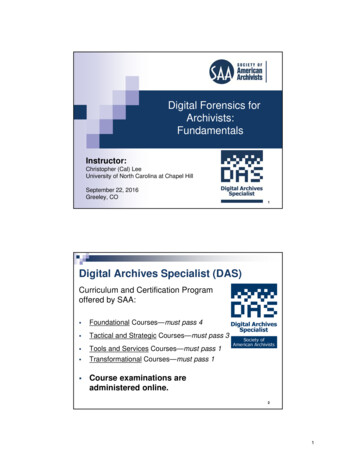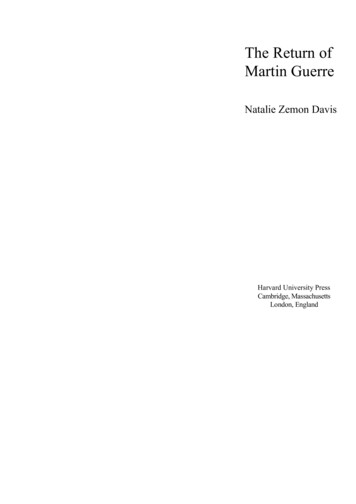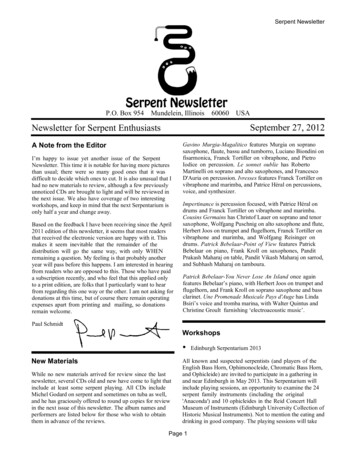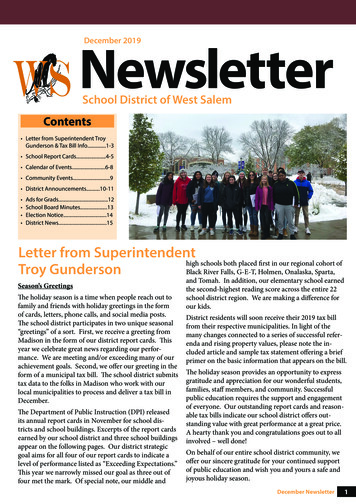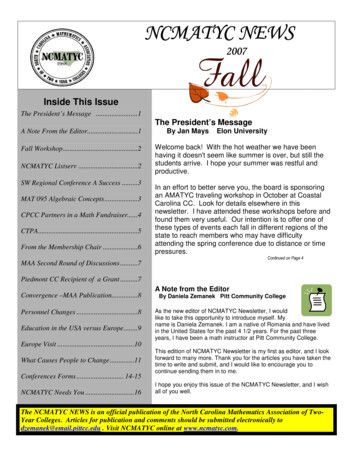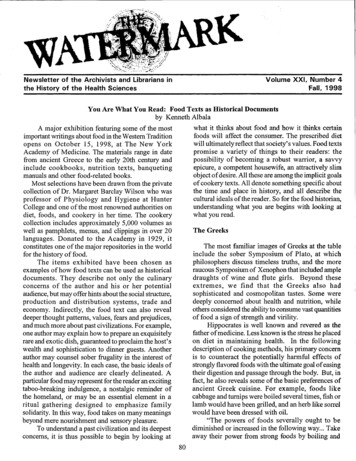
Transcription
Volume XXI. Number 4Fall. 1998Newsletter of the Archivists and Librarians inthe History of the Health SciencesYou Are What You Read: Food Texts as Historical Documentsby Kenneth Albalawhat it thinks about food and how it thinks certainfoods will affect the consumer. The prescribed dietwill ultimately reflect that society's values. Food textspromise a variety of things to their readers: thepossibility of becoming a robust warrior, a savvyepicure, a competent housewife, an attractively slimobject of desire. All these are among the implicit goalsof cookery texts. All denote something specific aboutthe time and place in history, and all describe thecultural ideals of the reader. So for the food historian,understanding what you are begins with looking atwhat you read.A major exhibition featuring some of the mostimportant writings about food in theWestern Traditionopens on October 15, 1998, at The New YorkAcademy of Medicine. The materials range in datefrom ancient Greece to the early 20th century andinclude cookbooks, nutrition texts, banquetingmanuals and other food-related books.Most selections have been drawn from the privatecollection of Dr. Margaret Barclay Wilson who wasprofessor of Physiology and Hygiene at HunterCollege and one of the most renowned authorities ondiet, foods, and cookery in her time. The cookerycollection includes approximately 5,000 volumes aswell as pamphlets, menus, and clippings in over 20languages. Donated to the Academy in 1929, itconstitutes one of the major repositories in the worldfor the history of food.The items exhibited have been chosen asexamples of how food texts can be used as historicaldocuments. They describe not only the culinaryconcerns of the author and his or her potentialaudience, but may offer hints about the social structure,production and distribution systems, trade andeconomy. Indirectly, the food text can also revealdeeper thought patterns, values, fears and prejudices,and much more about past civilizations. For example,one author may explain how to prepare an exquisitelyrare and exotic dish, guaranteed to proclaim the host'swealth and sophistication to dinner guests. Anotherauthor may counsel sober frugality in the interest ofhealth and longevity. In each case, the basic ideals ofthe author and audience are clearly delineated. Aparticular food may represent for the reader-an excitingtaboo-breaking indulgence, a nostalgic reminder ofthe homeland, or may be an essential element in aritual gathering designed to emphasize familysolidarity. In this way, food takes on many meaningsbeyond mere nourishment and sensory pleasure.To understand a past civilization and its deepestconcerns, it is thus possible to begin by looking atThe GreeksThe most familiar images of Greeks at the tableinclude the sober Symposium of Plato, at whichphilosophers discuss timeless truths, and the moreraucous Symposium of Xenophon that included ampledraughts of wine and flute girls. Beyond theseextremes, we find that the Greeks also hadsophisticated and cosmopolitan tastes. Some weredeeply concerned about health and nutrition, whileothers considered the ability to consume vast quantitiesof food a sign of strength and virility.Hippocrates is well known and revered as thefather of medicine. Less known is the stress he placedon diet in maintaining health. In the followingdescription of cooking methods, his primary concernis to counteract the potentially harmful effects ofstrongly flavored foods with the ultimate goal of easingtheir digestion and passage through the body. But, infact, he also reveals some of the basic preferences ofancient Greek cuisine. For example, foods likecabbage and turnips were boiled several times, fish orlamb would have been grilled, and an herb like sorrelwould have been dressed with oil."The powers of foods severally ought to bediminished or increased in the following way. Takeaway their power from strong foods by boiling and80
'Academy's manuscript,which is currently beingrestored, is one of two extant copies, the other residingin the Vatican Library. It is the best source ofinformation on early Roman eating and cookingbehavior.The recipe for "Chicken Varius" included in theApicius is named for the Roman Emperor, commonlyknown as Heliogabalus. He is primarily rememberedas a deranged, sadistic and extravagant tyrant. Thehistorian Aelius Lampridius depicts him feasting onflamingoes' brains, the heads of parrots, sow's udder,and vegetables seasoned with precious jewels. Oddlyenough, this recipe is quite elegant and subtly flavored,and reflects the high level of culinary expertiseachieved by the Romans."Chicken Varius: Cook the chicken in this sauce:garum, oil, wine, to which add a bundle of leeks,cilantro and savory. When it is cooked, crush pepper,2 cyathi of pine nuts and moisten them with the broth.Remove the bundle and combine with milk. Thencompletely empty the mortar over the chicken, let itboil. Thicken it with beaten egg whites. Place on adish and pour the above-mentioned sauce on top. It iscalled white sauce." (2 cyathi 1/6 of a pint)Celsus carried on the tradition of nutritional sciencebegun by the Greeks. He discussed the quantity ofnourishment offered by various foods, and revealedthe basic foundation of the Western diet: bread andmeat. Significantly, vegetables and fruits wereassigned inferior status by physicians, and they oftendiscouraged readers from using them. The basis ofthis opinion is the idea that like substances will nourishlike; the closer the analogy between food and diner,the easier the conversion from food to flesh. Pork iscooling many times; remove moisture from moistthings by grilling and roasting them; soak and moistendry things, soak and boil salt things, bitter and sharpthings mix with sweet, and astringent things mix withoily." (From: Hippocrates, Vol. 4. Translated byW.H.S. Jones. Cambridge: Harvard University Press,1967-1972. pp. 337-8)The RomansThe Romans had more complex taste preferencesthan the Greeks, and introduced a number of standardingredients to their cooking repertoire that made theircuisine unique. Among these are fermented fish sauce(garum), a grape juice concentrate (sapa), and the herbsilphium, which has since become extinct. The rangeof ingredients available and the sophisticated ways inwhich they were used are ample testimony to thebreadth of Roman trade. Fruits were imported fromPersia, spices from India, oysters from the coasts ofFrance and Britain, and salt from mines in Austria.Theirs is certainly the first internationally influencedcuisine in the West.The most important single item in the Academy'scookery collection is the ninth century Latinmanuscript, Apicius's De re coquinaria, which is areproduction of a classical text believed to be theearliest cookbook in theWestern World. Although theauthorship is in dispute, it is ascribed to the famousRoman astronomer, Apicius, a renowned epicure. TheApicius was probably completed during the end ofthe third century. The manuscript held at the Academywas compiled from a copy of this work, writtensometime before the ninth century and now lost. TheTABLE OF CONTENTS"You are What You Read: Food Texts as Historical Documents"80From the President84ALHHS Lunch-Time Proposal85News from HMDAnnouncements8689On the Web94From the 'Net96New Members/Directory Changes10281
have been carTied overland thousands of miles fromthe Orient.The recipe for "Venoison de CerfFraiche" instructsthat fresh venison be parboiled, then larded and cookedagain in wine and water with mace. It is then servedwith a cameline sauce (made with ginger, cinnamon,cloves, grains of paradise, mastic, long pepper, salt,and bread moistened with vinegar). Or it can be putinto a pastry with aromatic spices and served withcameline. Grain of paradise ormelegueta pepper camefrom West Africa and was popular throughout theMiddle Ages. It became completely unknown afterthe 16th century when importation was banned toprevent competition with black pepper, carried directlyfrom Asia by the Portuguese. Mastic is a resinous gumimported solely from Crete. (Guillaume Tirel (ca.1315-1395) The ViandierofTaillevent: an edition ofall extant manuscripts. Edited by Terence Scully.Ottawa: University of Ottawa Press, 1988.)the easiest to digest and the "lightest.". Beef, whileoffering the greatest amount of nourishment, is alsoamong the most difficult to digest. (Aulus CorneliusCelsus (P' c. A.D.) De medicina. Venice: PhilipumPinzi, 1497.)The Middle AgesThe most salient feature of medieval cuisine is theheavy use of spices including cinnamon, ginger,cloves, pepper, and several which have sincedisappeared from western tables. This tastepreference, the combination of opposing flavors, aswell as the penchant for brightly colored concoctions,was inherited from food traditions of the Muslimworld. Apart from being impressively expensive,these spices were also recommended as medicinalcorrectives for humorally imbalanced ingredients. Forexample, the excessively cold and moist fish couldbe corrected with hot and dry spices such as pepper,resulting in a much more nutritionally balanced dish.The RenaissanceWhile cooking in the early Renaissance remainsclosely tied to medieval traditions, in the 16th centurya series ofnew foods would be introduced into Europefrom the Americas, among them tomatoes, peppers,potatoes, com, and chocolate. Though these foodsdid not have an immediate impact on European foodcustoms, they would over time entirely transform theBooks on the History of Medicine Catalog on request Webb Dordick15 Ash Avenue, Somerville, MA 02145phonefaxCUISine.Platina's On honest pleasure was the most widelytranslated and published work on food in theRenaissance. From its publication in 1475, editionsin Latin, Italian, a German and a Dutch translation,and an expanded French version were all best sellers.Only an English translation had to await the 20thcentury. Both medical, culinary and historical, mostof its recipes were "borrowed" from a Maestro Martinoof Como, chef to the patriarch of Aquilea. Platinahimself was a humanist, and the first librarian of theVatican Library. The passage quoted below, in a selfconscious neo-classical Latin, points to the importanceof sugar in Renaissance cooking. Considered auniversal condiment, both nourishing and a digestiveaid, it was added liberally to nearly every kind of food.To a great extent, this obsession with sugar fueled theexploration of theNew World and transformed manyregions into sugar growing plantation economies."Sugar comes not only from Arabia and India, buteven Crete and Sicily. Pliny calls it honey collectedfrom canes. It crumbles when crushed or chewedbetween the teeth. Certainly the whiter it is, the better.(617) 776-1365(617) 629-0621The use of spices was, however, destined only for thetables of the rich. The average household wasconstrained to rely on native herbs and flavorings,especially parsley, sage, saffron, sorrel, and rue.Almond milk, sour vinegar, or verjuice-based sauceswere also unique elements in medieval cuisine.In 1370, Tirel became head chefto King CharlesV of France and his services were so revered that hewas granted a noble title. His cookbook remained thestandard guide for several centuries and definedelegant eating all across Europe. The following recipeincludes native venison, associated specifically withthe nobility who had exclusive rights to hunt. It is herecombined with what were extraordinarily expensiveexotic spices. The cameline sauce proves to the dinnerguest that this is not only a noble household, but awealthy one that can afford exclusive products that82
Rare Books & Manuscriptsin the history ofMedicine & the SciencesBought Sold Appraisedculinary and m dical, of The New York Academy ofMedicine Library.\-:******************************A Love Affair with Rare Books:A Personal Testimonyby Kenneth AlbalaAs an historian I try to spend as much time aspossible teaching students about the value of usingprimary source materials. Inevitably, students ask why:''what's so exciting about old books, dead authors,and long-forgotten arguments?" My immediateresponse always begins with the books then:selves.Sometimes I bring in a crumbling text or a smppet ofmanuscript in 16th century secretary hand, or we visitthe university's rare book room to read some 18thcentury books. Only after interacting directly with anartifact hundreds of years old does the thrill begin tosink in.I explain that the book is more than a series ofwords on a page. It is a living document that bothreflects and informs the deepest feelings of ourforebears: like the human hairs that lie imbedded inthe paper, perhaps fallen from the paper-maker's head;or the time I was using a farm account book and foundpinned onto the pages 500 year old weeds; there wasalso the plague victim registry that suddenly cuts of ,its author having presumably succumbed. I wonder 1fplague can be transmitted on paper? I also tell the storyof holding and reading a cookbook written down athousand years ago, and then rushing home to try outthe recipe. It was the Apicius at The New YorkAcademy of Medicine, the margins of which Isearched in vain for tell-tale sauce stains.My love affair with rare books began as anundergraduate working in the university rare bookroom. There were not many ofthe stiffvellum bindingsI would come to adore, but I got in the habit of pulling· the books out, and holding the pages up to the light tolook for chain lines and watermarks. I was obviouslyaddicted. One of my professors set me up with aninternship at the Folger Library. I was working upstairsat the Institute, but got to use the library whenever Iliked. But the clincher was a seminar at the Folgertaught by George Walton Williams, one of the "sonsof Fred" - Fredson Bowers, a titan of textual criticism.We spent our time counting signatures and gatherings,or discussing paper-making techniques.At any rate, the experience convinced me that,somehow, I had to spend the rest of my life near rarebooks. As a graduate student studying Renaissancehistory at Columbia University, one particular daySend for our latest catalogueJeremy Norman & Co., Inc.720 Market StreetSan Francisco, California 94102www .historyo:fi:nedicine.com(415) 781-6402FAX (415) 781-5504This usually happens as the result oflengthy refining,by which we mean being cooked three or more times.Its virtues are hot and moist, and thus it is verynourishing. It .helps the stomach, and soothes anyirritations there. But in the bilious it is easily converted ·into their dominant humor. I believe that the ancientsused it only as medicine. And for this reason nomention is made of it in their cooking . " (Platina(1421-1481) De honesta voluptate. De Saccharo(sugar) Book II, lOth entry. Venice: Laurentius deAquila and Sibyllinus Umber, 1475.)Cornaro was the most popular diet and health guruofhis day. After its first appearance in 1558, the SoberLife had been translated into nearly every Europeanlanguage, and actually has never gone out of print.Part of its success can be attributed to Cornaro's ownlife story. After a severe bout with illness, he decidedto live a sober and temperate life, was miraculouslycured, and survived to a ripe old age. Some editionsclaim he lived over a hundred years. Out of themainstream of medical writing, Cornaro's mainargument was that the particular foods one eats arenot as important as the quantity. Although he himselfabstained from fruit and fish, it was the strict frugalityand miniscule amounts of food he ate that proved sobeneficial. From contemporary evidence, it appearsthat many people bought the book and followed hisregimen. (Luigi Cornaro (1467-1566). Discorsi dellavita sobria. Venice: Marc Antonio Brogiollo, 1620.)In addition to the examples mentioned in this paper,the exhibit will include works by Dioscorides, Galen,Avicenna, Brillat-Savarin, Escoffier, and many others.This range reflects the remarkable holdings, both83
guest curator of the exhibition: You Are What YouRead: Food Texts as Historical Documents at TheNew York Academy of Medicine.sticks in my mind as pivotal. I was in a seminardiscussing bibliography and arcane Latin place names,and my advisor, Eugene Rice, mentioned offhand thatI should visit The New York Academy of Medicine.He waxed rhapsodic about the leather armchairs andmedical paraphernalia. So, with no particularexperience in the history of medicine, I made anappointment and trudged across the park on foot. Thiswould become a well-worn path, little did I know.The place was immediately captivating. I don'trecall how I found a dissertation topic there, but itwas largely determined by the holdings of the RareBook Room. I decided to tackle a seeminglyinsurmountable collection of dietary guides, in avariety of languages. The topic would bridge mylifelong obsession with food and my professionalpassion for old books, and almost inadvertently Ibecame a food historian on the fringes of the historyof medicine. It proved a fortuitous subject, and I spentmost of the early 90s ensconced in a leather armchairfrom 9 straight through to 5. All this had to come toan end after submitting my dissertation, graduating,and, alas, finding a job.Oddly enough, I never imagined how deeplyaffected I would be by living far away from rare books.I ended up in California at the University of the Pacific,nowhere near the sea, nor anywhere reasonably closeto rare books. A pleasant teaching load, excitingcourses, and an atmosphere that couldn't possibly bemore different from New York has kept me afloat, ashas learning to use primary documents as a teachingtool. However, far from the smell of vellum, the spiritcan languish.My exile ended this past summer, when theUniversity sent me to London to read what I hope arethe last remaining dietary regimens. I spent most ofthe time at the Wellcome Library, reading as fast as Ipossibly could, scribbling feverishly about the dangersof cucumbers and the aphrodisiac powers of parsnip.I still haven't made sense of all my notes, but the book,Food and Nutrition in the Renaissance, is one stepnearer to *******The New York Academy of Medicine is planningtwo lectures to accompany the exhibition. Theprogram is funded by a grant from the New YorkCouncil for the Humanities, as part of StateHumanities Month. The grant was developed by LoisFischer Black, Curator of Rare Books and Manuscriptsat The Academy. The first lecture by Kenneth Albala,Ph.D. The Culinary Text as Historical Document willbe held on Monday, October 19, 1998, at 6:00p.m.The second lecture by Elizabeth Pilliod, Ph.D. ASixteenth-Century Artist's Diary and the Notions ofMelancholy and Creativity will be held on Tuesday,October 27, 1998, at 6:00p.m. The exhibit will be onview from October 15, 1998 throughJanuary29, 1999.The lectures and exhibition are free and open to thepublic, and are part of a citywide collaborative projectheld in conjunction with The New School's Food:Nature and Culture conference in early November.FROM THE PRESIDENTThere must be a saying relative to the advancementof age and the speed of time. It seems like we werejust in Toronto enjoying a great conference site andmaking plans for the organization's future. Now it isFall, school has begun already, and Halloweencostumes are on the shelves along with Christmasdecorations. Many committee members have madegreat strides over the summer that has flown by.Several committees are working to assess the pastactivities of ALHHS, looking for ways to grow andimprove. Many thanks go to Suzanne Porter and herStrategic Planning Committee (John Parascandola,Lucretia McClure, Jodi Koste, and Barbara Irwin) whotraveled to the Tompkins-McCaw Library inRichmond, Virginia, on August 10. Many concernsand issues pertaining to the organization werereviewed. Discussions centered on an ALHHS missionstatement or statement of purpose, the organization'saffiliation with AAHM, budget development,programs, professional and educational development,awards, and the archives. The group continuesdiscussion of these issues.Also, many thanks to the Education Committee(Ed Morman, chair, Kathy Donahue, and Joan Klein)who have included a survey in this issue of TheWatermark. Please take a few moments to respond to****************************************Kenneth Albala, Ph.D., is assistant professor in theDepartment of History, University of the Pacific. Hispublications include "Fish in Renaissance DietaryTheory," "The History and Culture of Food inSouthern Europe," and "The Medical Origins ofCulinary Traditions. " He is presently working on thebook Food and Nutrition in the Renaissance. He haspresented papers at the Renaissance Society ofAmerica and the Oxford Food Symposium, and is the84
'ALHHS LUNCH-TIMEPROPOSALthe survey. This is your opportunity to take ownershipand have an effect on the organization. One of thegreat strengths of ALHHS is the expertise of themembership and its willingness to share ideas andprovide support.A proposal for a luncheon session at the 1999AAHM meeting in New Brunswick, New Jersey, hasbeen submitted by Joan Klein and appears in this issueof The Watermark. We would like to establish thepractice of submitting proposals for luncheon sessionsfor upcoming AAHM meetings to the EducationCommittee for discussion and review in order tocoordinate programs and educational opportunities.And, thanks to Stephen Greenberg from theHistorical Division of the National Library ofMedicine, who will be our local arrangements chairfor the meeting in Bethesda in the year 2000. Stephenhas agreed to do this despite the fact that he is workingon local arrangements on a broader scale withElizabeth Fee, AAHM Local Arrangements Chair.As always, I am open to anyone who would like toparticipate in the activities of the organization. Pleasefeel free to contact me with ideas, or to volunteer fora project or the annual meeting. It is fun and rewardingto become involved and we look forward to yourparticipation. Keep watching for news about ourmeeting in New Brunswick.PRIMARY RESOURCES IN THE DEVELOPMENTOF HEALTH POLICYProposal for a Lunch-time Roundtable Workshopsponsored by The Archivist and Librarians in theHistory of the Health Sciences (ALHHS) for theAmerican Association for the History of Medicine(AAHM)- 1999 Annual Meeting, New Brunswick,New Jersey.Primary resources can be a powerful tool to effectchange and the archivists and librarians responsiblefor these materials and the historians who use themcan be the catalysts necessary to transform publicopinion and revise policy. Nowhere is this truer thanin issues concerning the public's health. Thisroundtable workshop focuses on recent health policyevents where the use and availability of primaryresources helped produce dramatic changes in publicopinion and influenced the formulation of governmentpolicies. Archivists, historians, and policy makers willdescribe their roles in these recent events, discussissues surrounding the availability of these primaryresources, and methods and formats in whicharchivists and librarians can foster access to sensitiveinformation relevant to contemporary issues. Theimportant role memory plays in not letting these eventsfade from the nation's collective conscience and itsimpact on the development of health policy will alsobe addressed. On 16 May, 1997, President Clintonoffered an apology to the survivors of the infamousTuskegee Syphilis Study and, using the power of hisoffice, set in motion the reforms and initiativesrequired to tum the shameful legacy of Tuskegee intosomething positive and of long-lasting benefit tofuture generations. One presenter organized the 1994symposium which was the catalyst for establishingthe Tuskegee Syphilis Study Legacy Committee,which called for the Presidential apology. Radiationresearch conducted on humans by the Department ofEnergy and its predecessors during the Cold War yearsalso came under scrutiny and entered the arena ofgovernmental reform and public opinion. Onepresenter was a member of and historian for theAdvisory Committee on Human RadiationExperiments (ACHRE), appointed by PresidentClinton in January 1994, whose findings resulted inan apology delivered by President Clinton. Onepresenter was a key participant in the FDA'sinvestigation of smoking and the tobacco industry,which continues to make news. The FDA played apivotal role in making the public aware of healthElaine ChallacombeTROTTING HILL PARK BOOKSP.O. Box 60866 Longmeadow, MA 01116413-567-6466E-Mail: Bookrock@aol.comRare and ScholarlyMedical, Nursing, Dental, VeterinaryBooks, Manuscripts, EphemeraBroadsides & PhotographsCatalogues Sent On RequestAppraisals, Searches and Special Requests85
issues concerning tobacco. The workshop moderatorwill address the issues raised when a working archivistis faced with investigators tracking down primaryresources to develop policy.Participants:POST OFFICE BOX 1765SAUSALITO, CALIFORNIA 94966PHONE: (415) 332-1194FAX: (415) 332-5024Joan Echtenkamp Klein, M.S.L.S.Assistant Director for Historical Collections andServicesUniversity of Virginia Health Sciences Library, #234University of Virginia Health Sciences CenterCharlottesville, VA 22908804-924-0052 (0)804-979-4775 (H)804-924-0379 (F)jre@virginia. eduRare, important, and historic books in .MEDICINE, SCIENCE, TECHNOLOGY,BIBLIOGRAPHY, THE HISTORY OF IDEAS,AND 16th- AND 17th-CENTURY BOOKSIN MANY FIELDSJodi Koste, M.A.ArchivistSpecial Collections and ArchivesTompkins-McCaw LibraryBox 9980582Medical College ofVirginiaCommonwealth UniversityRichmond, VA 23298-0582804-828-9898 (0)804-794-6154 (H)804-828-6089 (F)jlkoste@vcu.eduCatalogues issued . Visitors by Appointment .Quotations solicitedEstablished in New York in 1964NEWS FROM HMDBy Elizabeth FeeChief, History of Medicine DivisionThe History of Medicine Division currently has 20full time staff, working with the assistance of 10contractors, 8 students, and several volunteers andvisiting scholars. Two recent additions to the staff areJan Lazarus, who returns after several years to workwith HISTLINE as a library technician and to assistin cataloging, and Michele Aleibar, a clerk-typist,juggler ofmultiple tasks, and a very cheerful presence.We will miss two HMD staffmembers who are leavingHMD for new positions: Sarah Richards, who isjoining the Health Resources and ServicesAdministration (HRSA) as senior program analyst forthe Bureau of Health Professions, and DavidVecchioli, who is joining the National Park Serviceas Archivist of the Morristown National HistoricalPark in Morristown, New Jersey. We will soon bestartingjob searches for staffmembers skilled in prints,photographs, and film collections and for a referenceand collection access technician.Susan E. Lederer, Ph.D.Associate ProfessorDepartment of HumanitiesMilton S. Hershey Medical CenterPennsylvania State University College of MedicineP.O. Box 850Hershey, P A 17033-0850717-531-8779 (0)717-566-4208 (H)717-531-3894 (F)sel5@psu.eduSuzanne White Junod, Ph.D.HistorianU.S. Food and Drug Administration6930 Needwood RoadRockville, MD 20855-1647301-827-3759 (0)301-208-9155 (H)301-443-7270 (F)sjunod@ora.fda.gov86
'Kreuterbiich Contrafeyt. (Frankfurt, 1546), the firstfolio edition of this compilation herbal based primarily· on the text of Otto Brunfels' herbal, but with additionalmaterial on the distillation of each of the plant essencestaken from Brunschwig's work.Digital Archives ProgramThree NIH scientists who received the Nobel Prize inMedicine: Drs. Julius Axelrod, Christian Anfinsen,and Martin Rodbell, are donating their manuscriptcollections to the National Library of Medicine. TheLibrary has also received selected manuscripts fromNobel Laureate Dr. Joshua Lederberg of RockefellerUniversity. Former NIH Director, Dr. Donald S.Fredrickson donated additional manuscripts to hiscollection of papers already at NLM. Taken as awhole, these valuable collections provide uniquedocumentation on the history of post-World War IIscience, and more specifically on the history ofbiomedical research and discovery at the NationalInstitutes ofHealth. The papers also offer insights intothe everyday world of scientists - their families,friendships, and communities at home and overseas.These collections form the core ofthe Library's newlyestablished Digital Archives Program, and will beorganized, cataloged, and digitized for access on theWorld Wide Web.Nachala Obshchei Voennopolevoi Khirurgii (Dresden,1865-1866), the rare first edition in Russian ofNicolaiPirogov's major treatise on military surgery,Grundziige der allgemeinen Kriegschirurgie (Leipzig,1864). Pirogov is considered the founder of modemRussian surgery.Exhibition ProgramWith visiting curators Robert Aronowitz and CarlaKeirns, the exhibition program team is working onBreath ofLife, which is scheduled to open to the publicin March 1999. The exhibition examines asthma'schanging definitions, explanations, and treatments,and examines cultural influences on the understandingand experience of asthma. The exhibition will featurebiographies of noted historical figures, contemporarycelebrities, and "local heroes" who had or have asthma.The exhibition team is collaborating with SheldonCohen, widely recognized scientist and historian, todevelop the historical biographies -many of whichare drawn from Dr. Cohen's publications andforthcoming books.HistoricalAV, Prints & Photographs: AcquisitionsThe History of Medicine Division received 46videocassettes from the Alpha Omega Alpha HonorMedical Society of interviews with leaders inAmerican medicine, including Drs. Robert Petersdorf,David E. Rogers, Joseph E. Murray, C. Everett Koop,and George T. Harrell, among others. HMD alsoaccepted 49 still images: 2 posters donated by theNational Institute on Drug Abuse; 29 health posterson Parkinson's disease, cancer, influenza, AIDS,hepatitis, etc. donated by William Helfand; 12 oilpaintings, some showing the Public
manuals and other food-related books. Most selections have been drawn from the private . foods, and cookery in her time. The cookery collection includes approximately 5,000 volumes as well as pamphlets, menus, and clippings in over 20 languages. Donated to the Academy in 1929, it . Italian, a German and a Dutch translation,

